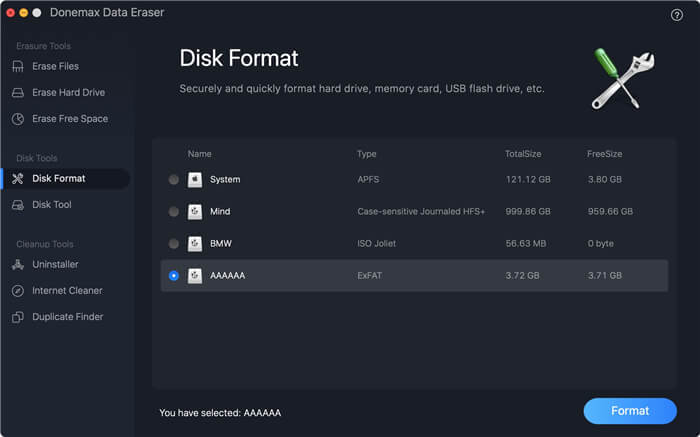

- USB DRIVE FORMAT MAC HOW TO
- USB DRIVE FORMAT MAC MAC OS
- USB DRIVE FORMAT MAC MAC
- USB DRIVE FORMAT MAC WINDOWS
Select the preferred USB Drive from the menu on the left side of the screen.Ĭlick on “ Erase” on the top toolbar. When you open the “Disk Utility,” the tool will look like below: You can find the “Disk Utility” tool inside the “Utilities” folder.

In the “Applications” folder, find the folder named "Utilities," and navigate to it. If you aren’t able to bring up “Spotlight Search” for some reason, navigate to the “Finder” directory and click on “Applications”.
USB DRIVE FORMAT MAC MAC
Under “Format,” you can see the format of your device.įormatting a Flash Drive Disk Utility on your Mac Once you click on "Get Info," you’ll be presented with information on the device. Right-click on the device name and click on "Get Info". Navigate to the Finder directory and look for your device on the left side menu. There are two ways you can approach reformatting a thumb drive:īefore formatting the USB Drive, check the current Format of your drive. Unless this is specifically required, we recommend the "Journaled" format Two Easy Ways to Reformat a USB drive

This is similar to the Journaled format except for the fact that all folder names are case-sensitive.įor example, the file format differentiates a folder named " MYFOLDER" from a folder named " myfolder".
USB DRIVE FORMAT MAC MAC OS
Mac OS Extended (Case-sensitive, Journaled) It uses the Mac format to protect the integrity of the hierarchical file system. This is the recommended file system for devices that are used with Macbooks.

Unless a system specifically calls for FAT32 devices, avoid this format at all costs. For example, you can only store files that are less than 4GB on the device. This file format is highly compatible but somewhat limiting. This file format is compatible with multiple devices, like PCs and gaming consoles.
USB DRIVE FORMAT MAC WINDOWS
If you plan on using your USB on both Windows and macOS devices, the preferred format is ExFAT. Different File System Formats Available in Disk Utility ExFAT
USB DRIVE FORMAT MAC HOW TO
Let’s look at how to format your thumb drive for a Mac. Unless it’s specifically designed to work on a macOS, you'll need to reformat the flash drive. It’s because most computers run on Windows and most thumb drives ship with formats that favor a Windows environment. If you need to back up any information on the drive, first connect your drive to a computer that does recognize the drive and transfer the data to a new storage device.Have you ever tried to use a USB drive on your Mac only to realize you couldn’t write any files to it? Choose "Mac OS Extended (Journaled)" to use the default Mac file system format. Click the "Format" drop-down menu and select the format you want to use. Select your hard drive from the list and click the "Erase" tab. Restart "Disk Utility" if you had to restart your computer to perform a repair and you still don't see your drive. You may need to restart your computer and follow the prompts to complete the repair.Ĭlick the "Finder" icon in the Dock and look for your drive in the sidebar. If the operating system already mounted the drive, an "Unmount" button displays instead.Ĭlick the "First Aid" tab and select "Repair Disk," if available. Select your hard drive, optical drive or other attached drive in the sidebar. Click "Go" and select "Utilities" from the drop-down list. Click the background to bring up the Finder menu in the the top bar.


 0 kommentar(er)
0 kommentar(er)
